The Suzuki Swift is a stalwart in Australia’s light car segment.
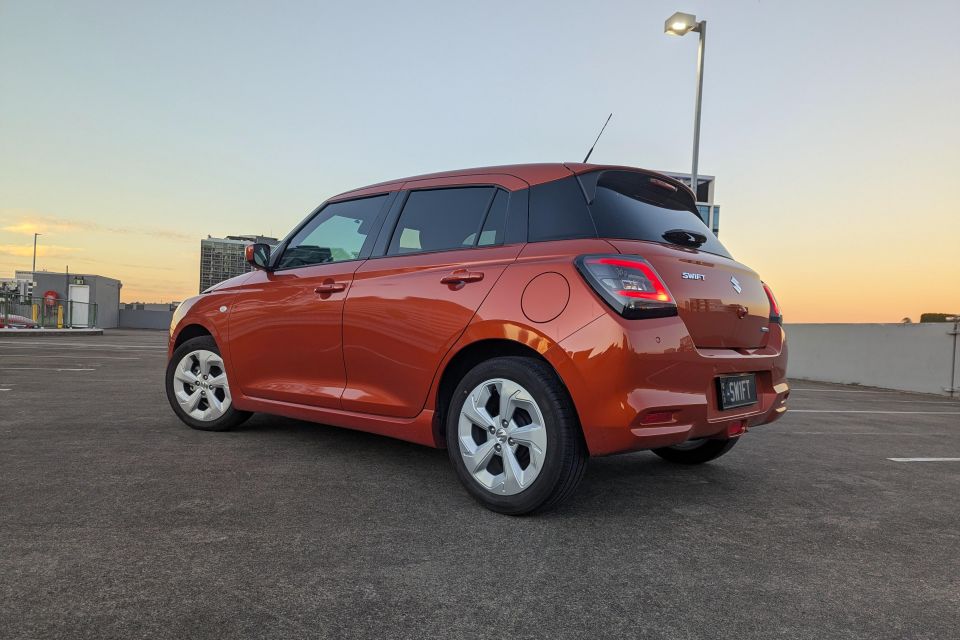
It seems like everyone has had one in their family, or at least had a friend or colleague that’s owned one.
Suzuki has also grown its share of the light car segment over the years, but that’s largely because the segment itself has been shrinking.
Rewind to the first half of 2015, and Suzuki sold 6032 Swifts, giving it a 10.9 per cent share of a segment that had close to 20 offerings. In the first half of 2025, it had a 17.4 per cent share but just 1953 sales.
Sales of light cars are around a fifth of what they were 10 years ago, and there are now just four vehicles in the Swift’s segment including the Suzuki itself.
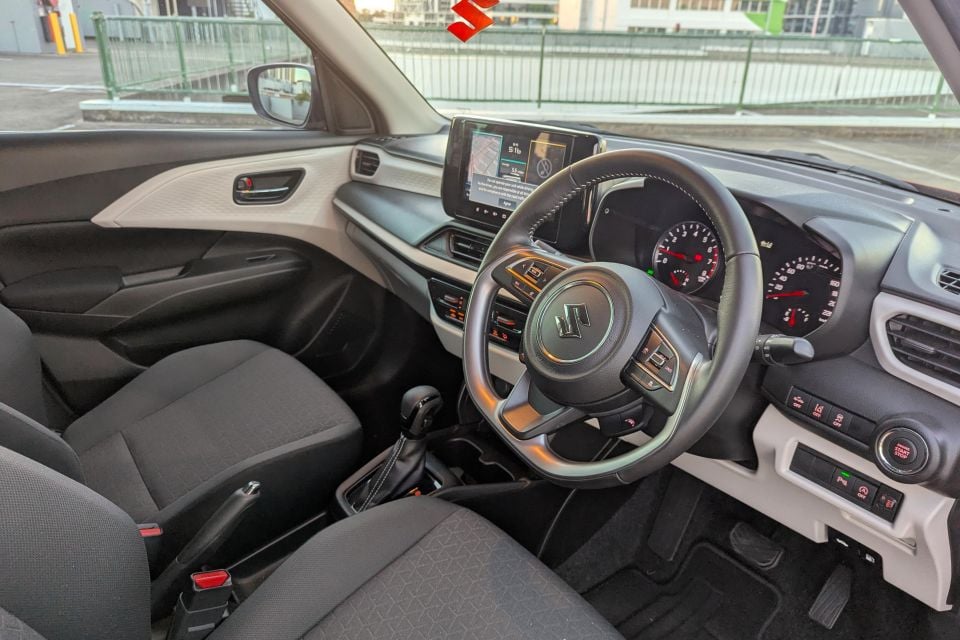
So what’s happened in the past 10 years? Increasingly smaller and more affordable SUVs have arrived, including the Hyundai Venue, Kia Stonic and more recently Suzuki’s own Fronx, while the MG 3 came in and shook the light hatch segment up with its bargain basement pricing.
There’s a new MG 3 now that isn’t selling quite as well, but it’s still the segment victor by far, with the Swift, Mazda 2 and Toyota Yaris all fighting for second-place.
One thing that hasn’t changed all that much in the past 10 years is the Swift’s styling. Oh, sure, we’re up to the fourth generation of the modern Swift now, but Suzuki’s designers continue to work on variations of a theme.
I’d argue it’s both derivative of the previous three generations and yet not as attractive as them with its heavy side creasing and tacked-on reversing camera. Suzuki designers, feel free to shake things up next time around – we know you’re capable of some fresh and funky designs like the Jimny and Ignis.
How much does the Suzuki Swift cost?
The mid-range Swift Plus is currently priced at $26,990 before on-road costs, and is currently being offered for $28,990 drive-away nationwide.
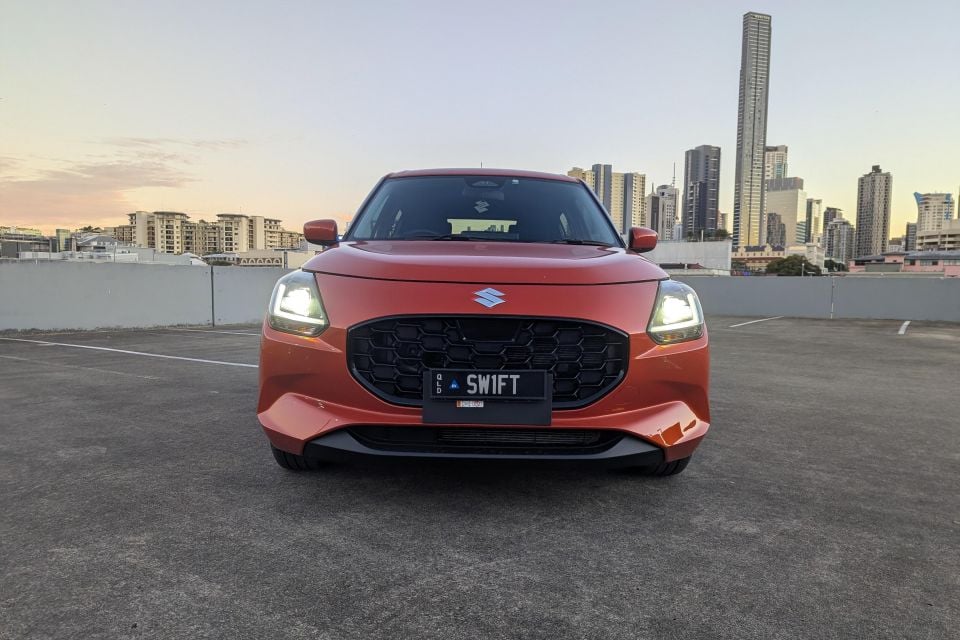
| Model | Price before on-roads |
|---|---|
| 2025 Suzuki Swift Hybrid manual | $24,490 |
| 2025 Suzuki Swift Hybrid auto | $25,490 |
| 2025 Suzuki Swift Hybrid Plus auto | $26,990 |
| 2025 Suzuki Swift Hybrid GLX auto | $27,990 |
Even the most affordable Toyota Yaris – which features a proper hybrid powertrain, not the mild-hybrid setup of the Suzuki – is more expensive at $28,990 before on-roads, as is the Mazda 2 at $27,585 plus on-roads after Mazda culled its most affordable variants.
However, the MG 3 – even in its new, more expensive generation – continues to undercut the Swift. The MG 3 Hybrid+ is priced from $28,990 drive-away, while petrol-powered variants can be had for even less.
To see how the Suzuki Swift lines up against the competition, check out our comparison tool
What is the Suzuki Swift like on the inside?
Suzuki has gotten the fundamentals right in the Swift’s interior, and given it some funky touches that stop it from feeling too dour.

There’s white contrasting plastic trim across the dash and doors, some of it featuring an unusual pattern on it. We’re concerned how this trim will wear, but at least in a brand-new Swift it helps break up the sea of black plastic that’s typical in a car at this price point.
The comfortable seats have attractive patterned cloth upholstery. They also feature heating, but there’s only one stage so unless you’re driving in Antarctica, you’ll probably turn them on, quickly heat up your posterior, and then turn them off.
You won’t find any soft trim in the cabin, except for the armrests and of course the seats themselves. This isn’t unusual for this segment, and everything does feel solidly put together, even if the rather wide panel gaps of the exterior appear to tease a subpar interior.
Sadly, there’s no centre console bin, so there’s no place to rest your arm or conceal valuables. You do get an open storage compartment, a pair of cupholders, and a small shelf on the centre console however.
Perched atop the dashboard is a responsive 9.0-inch touchscreen for the infotainment system, and it has a straightforward interface including shortcuts at the bottom of the screen, plus touch-capacitive switches underneath it. It has a rather thick bezel, but it’s a large screen for the segment.
We’re glad to see physical climate controls, but they’re a little odd. It’s essentially the same climate control array as the Fronx, with rocker switches for fan speed and temperature adjustment.
But this isn’t automatic climate control, so you instead flick the temperature toggle up or down to choose between 10 different ‘cold’ temperatures and 10 different ‘warm’ ones – a traditional knob would be preferable.
The instrument cluster features attractive and legible analogue dials, flanking a small screen. This displays various pieces of information, and will even display your turn-by-turn navigation instructions when you’re using Google Maps via smartphone mirroring.
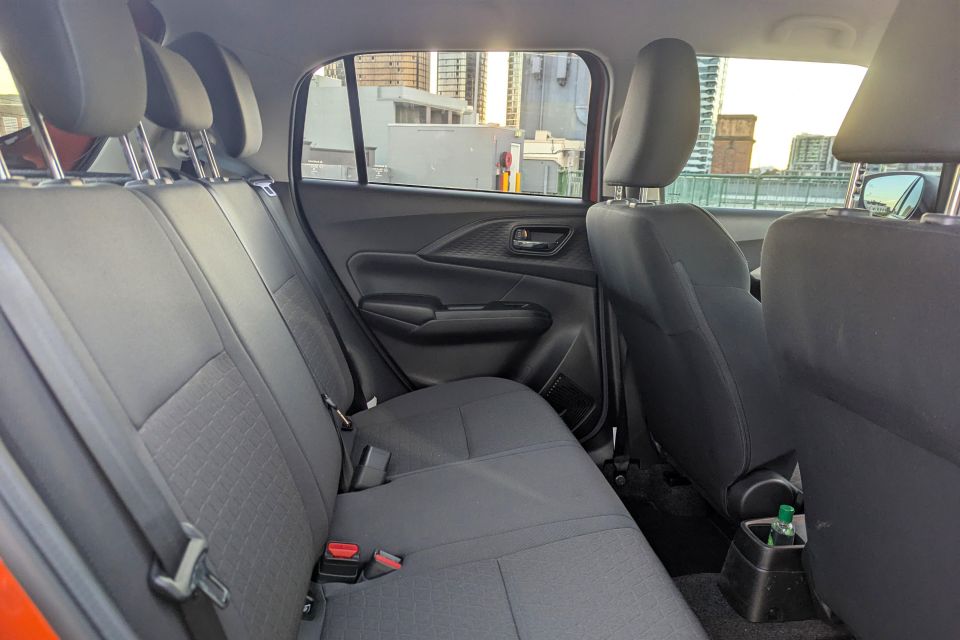
Suzuki has largely kept up with the times – there’s even a digital speed readout on the instrument cluster screen! – but there’s one odd, retrograde touch. While you can use the Info button on the steering wheel to toggle between different displays on the instrument cluster screen, to do things like reset the average fuel consumption you have to use this weird black twisty knob poking out of the cluster. It’s annoying to use.
Some aspects of the interior we do like, however, are the large, clearly labelled buttons on the right-hand side of the steering wheel including the boot release, and the bottle holders in the front doors that will fit larger bottles.
One advantage of Suzuki sticking with the same basic silhouette for two decades is it affords the Swift excellent rear headroom. At 180cm tall, my head doesn’t brush the ceiling, and legroom is quite good too – I can sit behind my own seating position with no problem.
There are no amenities of note here, apart from bottle holders in the doors suitable only for small bottles.
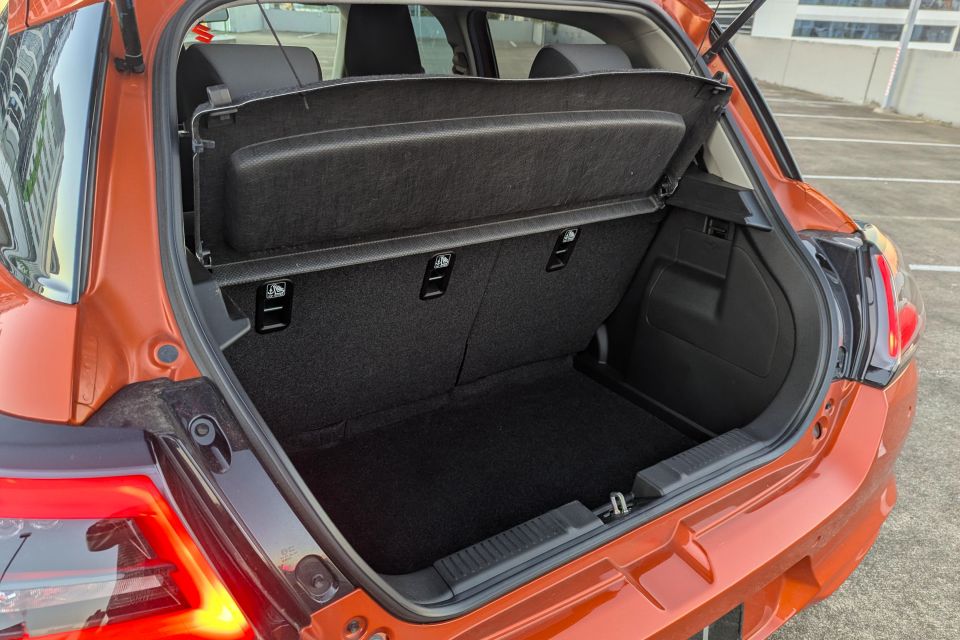
Open the hatch and you’ll find quite a deep storage space. There’s 265 litres of space, which compares favourably with the MG 3 (293L), Mazda 2 (250L) and Toyota Yaris (270L).
Under the boot floor, however, there’s no spare – just a tyre repair kit.
| Dimensions | Suzuki Swift |
|---|---|
| Length | 3860mm |
| Width | 1735mm |
| Height | 1520mm |
| Wheelbase | 2450mm |
| Cargo capacity | 265L |
To see how the Suzuki Swift lines up against the competition, check out our comparison tool
What’s under the bonnet?
All versions of the Swift Hybrid in Australia get a 1.2-litre petrol engine with a 12V mild-hybrid system.
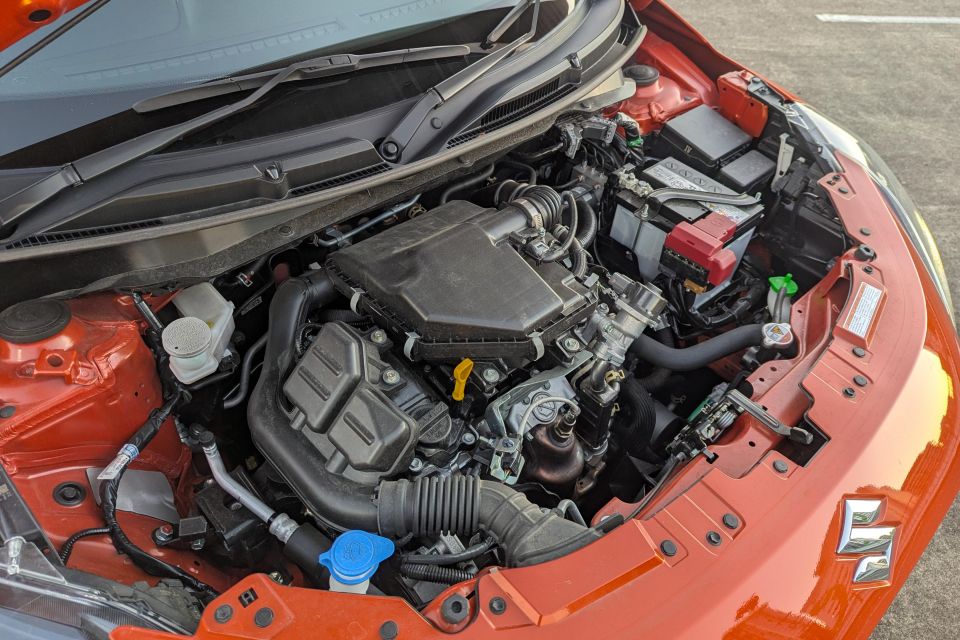
| Specifications | Suzuki Swift Hybrid |
|---|---|
| Engine | 1.2L 3cyl MHEV |
| Power | 61kW @ 5700rpm |
| Torque | 112Nm @ 4500rpm |
| Transmission | CVT |
| Drive type | Front-wheel drive |
| Weight | 957kg |
| Fuel economy (claimed) | 4.0L/100km |
| Fuel economy (as tested) | 4.7L/100km (loop) 5.7L/100km (over the course of a week) |
| Fuel tank capacity | 37L |
| Fuel requirement | 95-octane premium unleaded |
| CO2 emissions | 90g/km |
| Emissions standard | Euro 6 |
Over a loop consisting of inner-city, suburban and highway driving, we recorded fuel consumption of 4.7L/100km. This increased to 5.7L/100km over the course of a week, albeit with a heavy urban skew.
For context, across an identical loop we recorded 4.9L/100km with a base manual Swift, and 5.1L/100km over the course of a week.
To see how the Suzuki Swift lines up against the competition, check out our comparison tool
How does the Suzuki Swift drive?
As an urban runabout, the Suzuki Swift works well.

The CVT keeps the little three-pot in its optimal rev range, and you can dart in and out of traffic with ease.
The thrummy note of the three-cylinder engine under the bonnet is also delightful, though it makes a racket – and betrays its modest outputs – when you floor it on a highway on-ramp, with a great deal of droning from the CVT.
The steering should satisfy most buyers. It’s light without feeling completely vacant, and the Swift is easily twirled around parking lots.
Ride quality meets the standards of the segment, and the Swift is generally comfortable. Multiple successive bumps will upset its composure somewhat, but generally impacts are absorbed quite well. It’s not a Cadillac, but it’s comfortable.
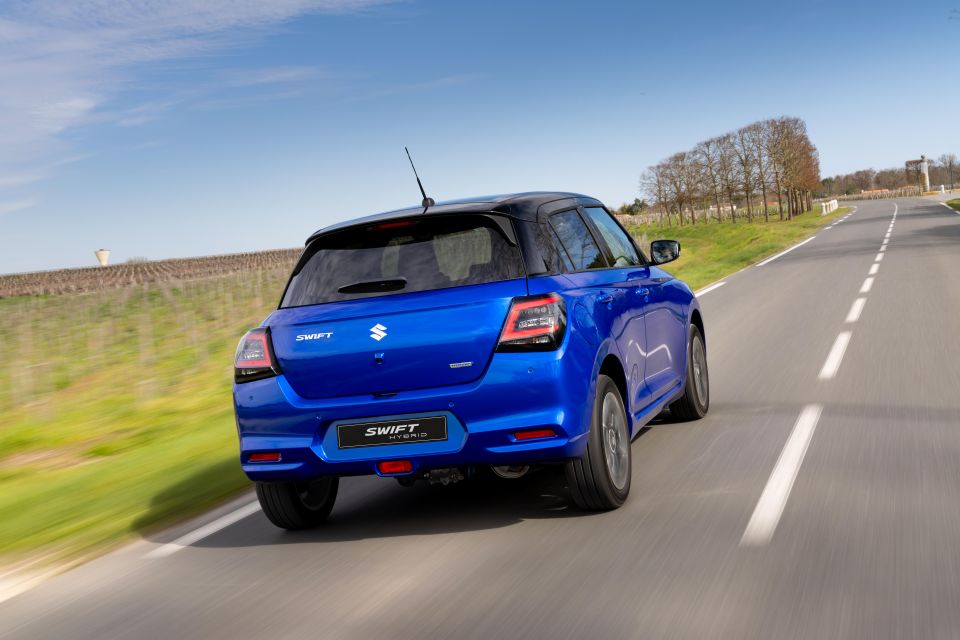
Visibility is also hard to fault, with nice, large windows all around the vehicle. Despite this, blind-spot monitoring is still standard, and it’s great to see this genuinely useful safety technology in an affordable light car.
The only thing that may perturb commuters is the idle stop/start system. In stop and start traffic the engine is very keen to cut out, and the system is quite smooth so you may be surprised to find all of a sudden the steering wheel essentially won’t move while you’re waiting at traffic lights.
Cruising along the highway, there’s a little wind rustle around the mirrors and a little bit of tyre noise, but it’s fine by the standards of the segment – you can still easily carry a conversation with someone in the back seat, not that that they’re that far away from you!
The sound system also features speed-dependent volume control.
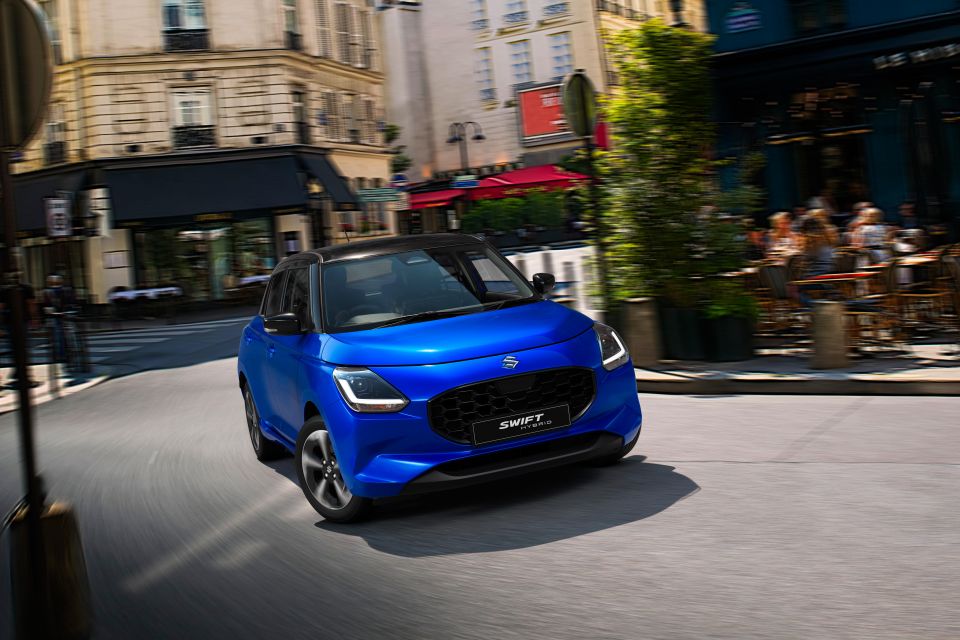
In other driving scenarios, the Swift is a little less desirable.
It’s just not as entertaining as a Mazda 2 to drive when you want to take it somewhere more challenging than the commute to work. There’s more body roll in corners, a bit more understeer, and a bit less steering feel. Even an MG 3 Hybrid I recently drove was more enjoyable on a spirited mountain drive.
Are most Swift buyers after a corner-carver? Probably not. If you do crave that engagement but insist on a Swift, you can either wait for a new-generation Sport – if one ever comes – or drop down to the base model and get a manual.
The three-pedal option makes this little hatch somewhat more enjoyable. Shift action is good and throws aren’t too long, nor does it feel too rubbery or notchy; the clutch pedal is well-weighted, too.
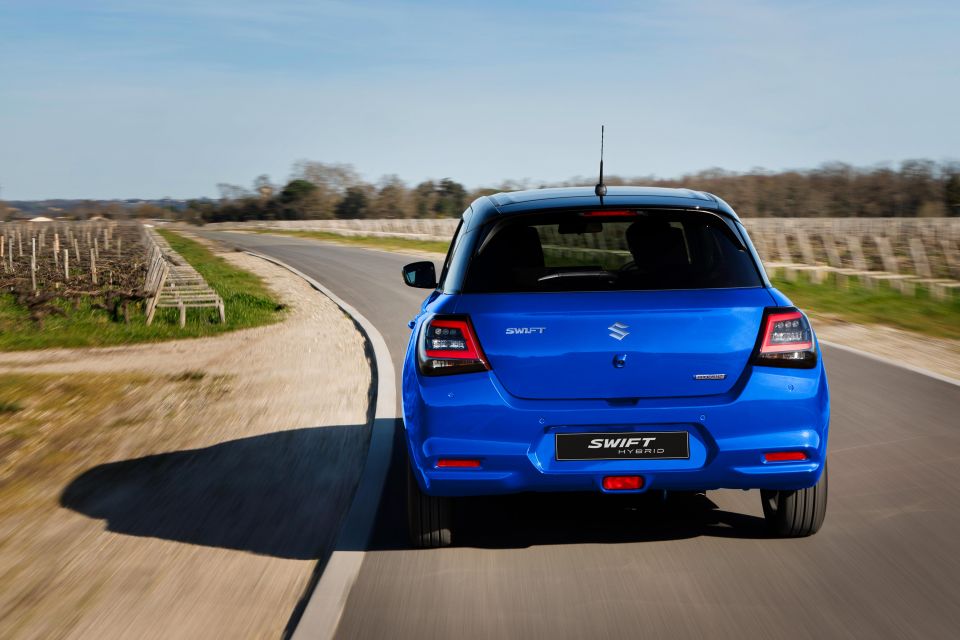
It’s still not my favourite manual but it’s the only one left in this segment in Australia, unless you step up to a Hyundai i20 N. Also, surprisingly, the manual also comes with adaptive cruise control.
To get blind-spot monitoring and rear cross-traffic alert in a Swift, however, you have to step up to our auto-only Plus tester, and they join a suite of active safety and driver assist technology that’s generally well-calibrated.
The lane-keep assist gives you a gentle nudge if you start to stray out of your lane, while there’s also a lane centring function that works with the adaptive cruise control.
It’s not the sharpest lane-centring system we’ve tested – it makes the steering feel quite inconsistent – but it’s great to see such a feature in a humble Swift.
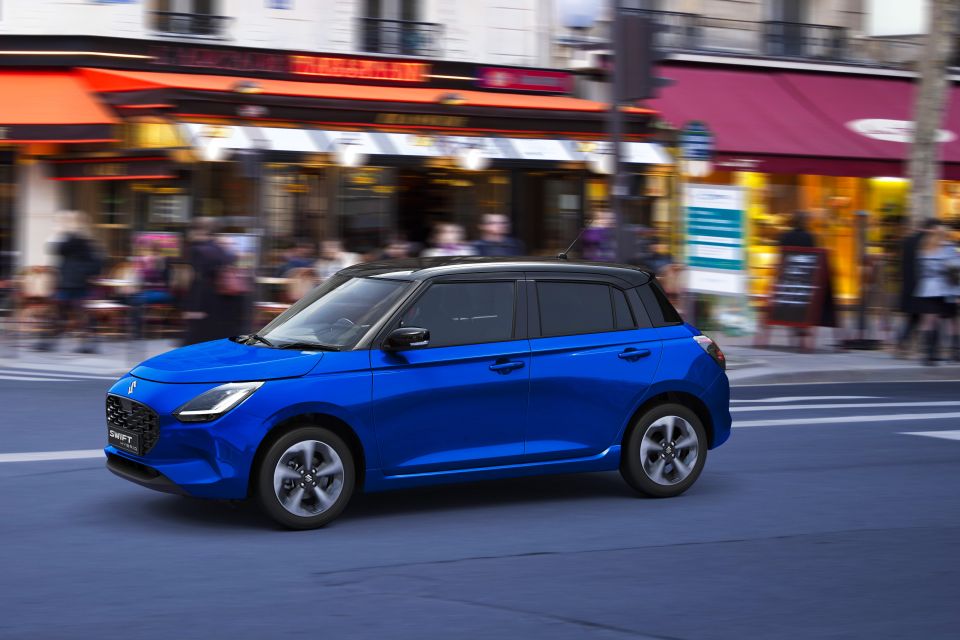
Trusted Reviews, Smarter Choices, Better Prices
Where expert car reviews meet expert car buying – CarExpert gives you trusted advice, personalised service and real savings on your next new car.
The adaptive cruise control lacks stop and go functionality but, again, it’s a Swift with adaptive cruise – even Suzuki has kept up with the march of progress. Handily, it works with the speed sign recognition, which means you need press only one toggle on the steering wheel to change the set speed.
As required by law, there’s autonomous emergency braking, and while it didn’t engage on us the forward collision warning did activate a few times showing it’s rather more eager than in other cars. You can turn it off easily, however, via a button to the right-hand side of the steering wheel next to the lane-keep assist button.
The standard LED headlights feature automatic high-beam, which works well. There’s a reversing camera, as expected, and its resolution is average.
To see how the Suzuki Swift lines up against the competition, check out our comparison tool
What do you get?
The Swift is available in three trim levels: base, the featured Plus, and the top-spec GLX.
2025 Suzuki Swift equipment highlights:
- 15-inch steel wheels with covers
- Tyre repair kit
- LED headlights
- Heated power mirrors
- Keyless entry and start
- 9.0-inch touchscreen infotainment system
- Wireless Apple CarPlay
- Wired Android Auto
- Satellite navigation
- DAB digital radio
- 2-speaker sound system
- Air-conditioning
- Cloth upholstery
The Plus adds:
- 16-inch alloy wheels
- Heated front seats
- Leather-wrapped steering wheel
- Driver’s seat height adjustment
- 6-speaker sound system
The GLX adds:
- Wireless phone charger
- Climate control air-conditioning
- Power-folding exterior mirrors
To see how the Suzuki Swift lines up against the competition, check out our comparison tool
Is the Suzuki Swift safe?
The Suzuki Swift received a one-star rating from safety authority ANCAP in 2024, a disappointing showing given its predecessor had received five stars under admittedly older, less stringent protocols.
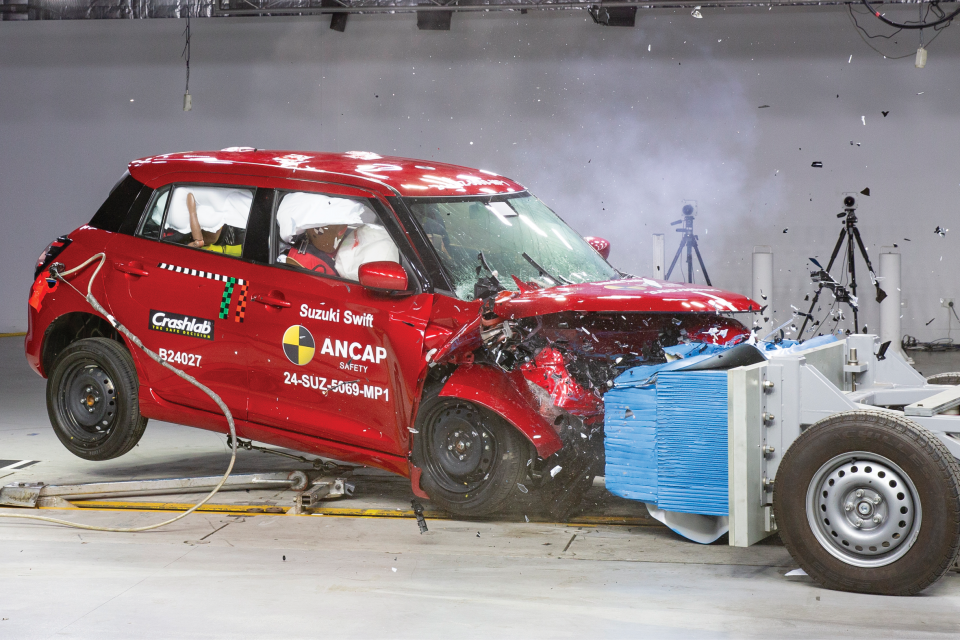
| Category | Suzuki Swift |
|---|---|
| Adult occupant protection | 47 per cent |
| Child occupant protection | 59 per cent |
| Vulnerable road user protection | 76 per cent |
| Safety assist | 54 per cent |
The current model received a three-star rating from sister authority Euro NCAP, but different specification locally – including the absence of absorption bars around the radiator and on either side of the wheel arch – doomed it to just one star in ANCAP testing.
Given ANCAP standards change over time, the Swift can’t be directly compared with anything in its segment besides the MG 3. The Chinese hatch received three stars in ANCAP testing under the same protocols.
The Yaris received five stars in 2020, but against older test protocols, while the Mazda 2 received five stars but its rating expired in 2022 because testing was conducted all the way back in 2014. Other similarly priced vehicles like the Kia Picanto and Stonic are also unrated.
What does all this mean? Well, we’d argue Suzuki is giving Australian buyers the short end of the stick by not offering a version of the Swift demonstrated to be safer.
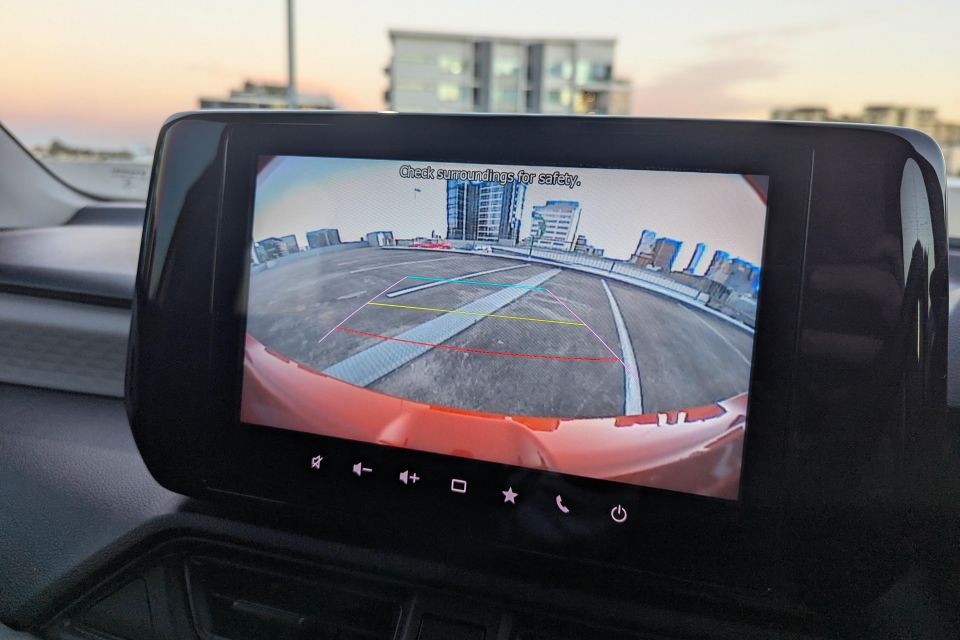
We’re not talking about driver assist features here, which we know many vehicle owners turn off. The Australian-market Swift received 47 per cent for adult occupant protection and 59 per cent for child occupant protection, against 72 per cent and 74 per cent respectively for the MG 3, and 67 per cent and 65 per cent in Euro NCAP testing of the European-market Swift.
Could a new Swift be safer than what you’re trading in for it? Quite possibly, particularly if you’re coming out of an older vehicle. But a one-star rating is disappointing in a market where five stars has become the norm.
On a brighter note, the Swift comes standard with plenty of safety features, particularly in the mid-spec Plus and top-spec GLX.
Standard safety equipment across the Swift range includes:
- Adaptive cruise control
- Autonomous emergency braking
- Lane-keep assist
- Traffic sign recognition
- Reversing camera
- Rear parking sensors
- Front, front-side and curtain airbags
The Plus adds:
- Blind-spot monitoring
- Rear cross-traffic alert
That’s plenty of safety kit, but rivals have kept up – every Mazda 2 has all of the above features, for example. The MG 3, too, has an extensive list of standard active safety and driver assist tech.
To see how the Suzuki Swift lines up against the competition, check out our comparison tool
How much does the Suzuki Swift cost to run?
Suzuki covers its range in Australia with a five-year, unlimited-kilometre warranty.
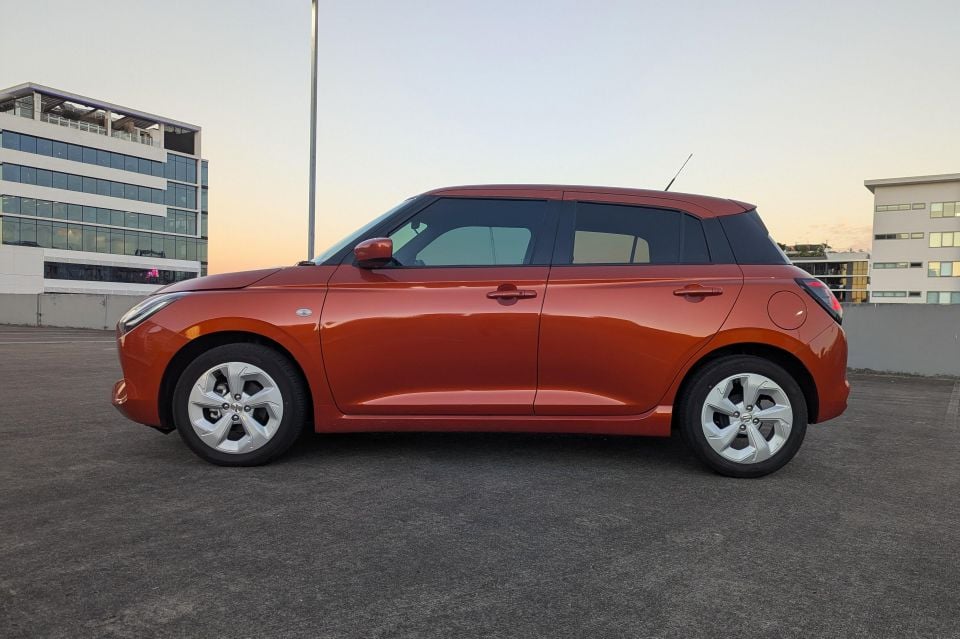
| Servicing and Warranty | Suzuki Swift |
|---|---|
| Warranty | 5 years, unlimited kilometres |
| Roadside assistance | 5 years (service-activated) |
| Service intervals | 12 months or 15,000km |
| Capped-price servicing | 7 years |
| Average annual service cost (5 years) | $391 |
| Total capped-price service cost (5 years) | $1955 |
To see how the Suzuki Swift lines up against the competition, check out our comparison tool.
CarExpert’s Take on the Suzuki Swift Hybrid
There’s a lot to like about the Suzuki Swift, from its thrifty, thrummy three-cylinder engine to its comfortable cabin and its user-friendly controls and infotainment system.
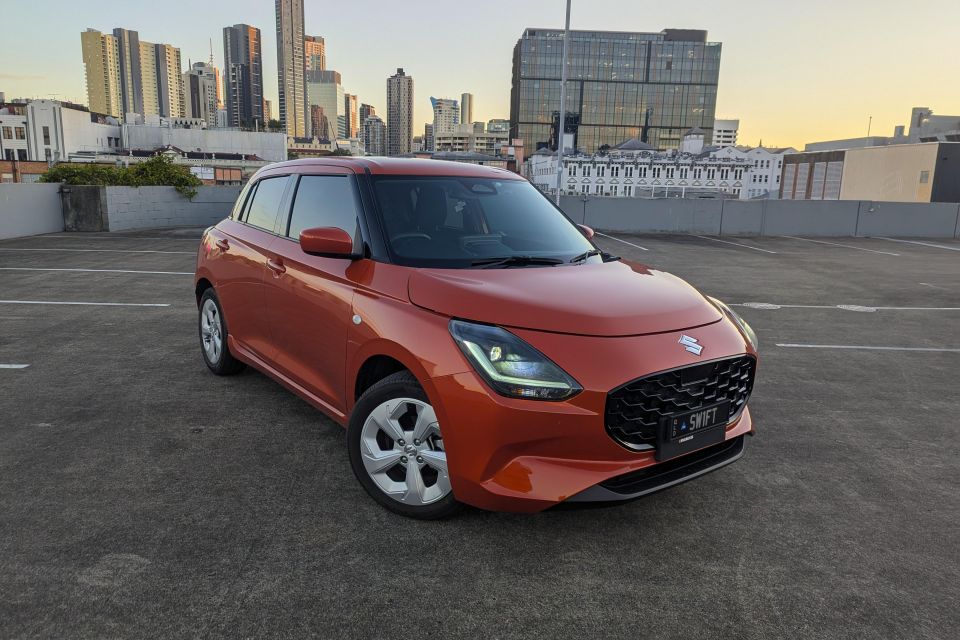
It also undercuts the Mazda 2 and Toyota Yaris, if not the MG 3, and proves a very easy car to live with.
But its disappointing safety result is a tough pill to swallow, and it isn’t as enjoyable to drive as its rivals.
It also requires more expensive fuel than a Mazda 2 or Toyota Yaris, and there’s no spare wheel like you’ll find in the Yaris or a petrol MG 3.
We hope Suzuki can bring the Australian-market Swift into line with its European-market counterpart. In the meantime, it’s still worth a look but we’d also suggest you check out the MG 3.
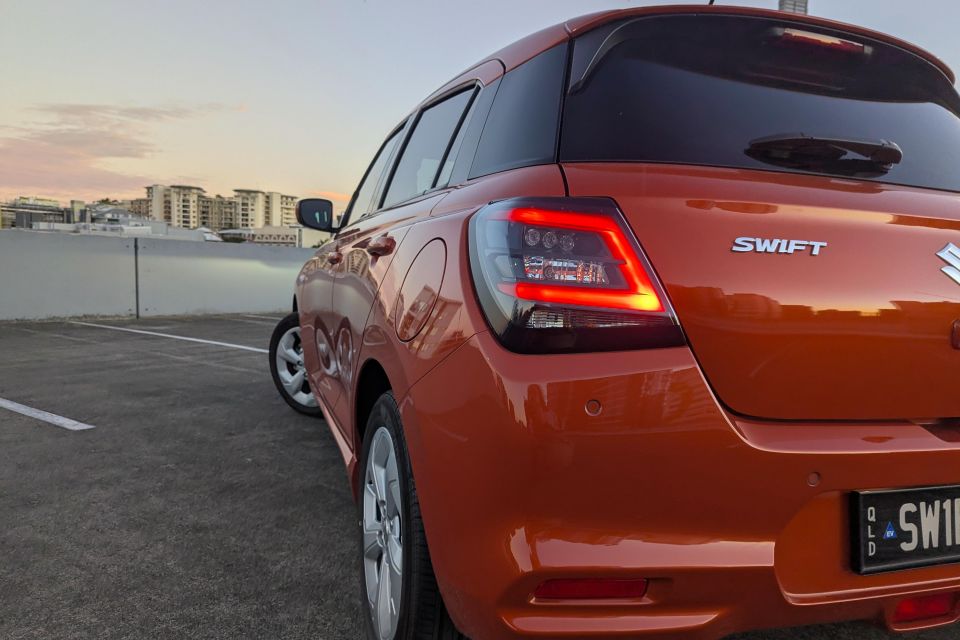
CarExpert can save you thousands on a new Suzuki Swift. Click here to get a great deal.
Click the images for the full gallery

